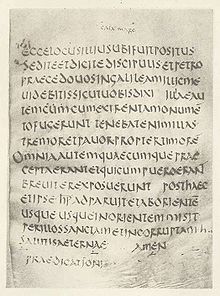Codex Bobiensis

Codex Bobiensis or Bobbiensis (Siglum k, VL 1 by Beuron) is one of the oldest Old Latin manuscripts of the New Testament. The fragmentary text contains parts of the Gospel of Mark (Mark 8:8-16:8) and Gospel of Matthew (Matthew 1:1-15:36).[1]
Codex Bobiensis is the only known example of the shorter ending added directly to Mark 16:8, but not the "longer ending" through Mark 16:20.[2]
The Latin text of the codex is a representative of the Western text-type.
History
[edit]It was probably written in North Africa, and is dated to the 4th or 5th century. Later, it was brought to the monastery in Bobbio in northern Italy. It was traditionally assigned to St. Columban, who died in the monastery he had founded there, in 615.[3] Today it is housed in the Turin National University Library.
Researchers, comparing the Codex Bobiensis with quotes from Cyprian’s publications from the 3rd century, think it may represent a page from the Bible Cyprian used while he was a bishop in Carthage. A palaeographic study of the scripture determined it is a copy of a papyrus script from the 2nd century.
In Matthew 8:12 it represents textual variant ἐξελεύσονται (will go out) instead of ἐκβληθήσονται (will be thrown).
This variant is supported only by two Greek manuscripts Codex Sinaiticus, Codex Climaci Rescriptus, and by syrc, s, p, pal, arm, Diatessaron.[4]
There is a unique reading following Mark 16:3:
- Subito autem ad horam tertiam tenebrae diei factae sunt per totum orbem terrae, et descenderunt de caelis angeli et surgent in claritate vivi Dei (viri duo?); simul ascenderunt cum eo, et continuo lux facta est.[5]
The text requires some guesswork. Bruce Metzger provides the following translation:
- But suddenly at the third hour of the day there was darkness over the whole circle of the earth, and angels descended from the heavens, and as he [the Lord] was rising in the glory of the living God, at the same time they ascended with him; and immediately it was light.[6]
The "Shorter Ending" runs as follows:
- Omnia autem quaecumque praecepta erant et qui cum puero erant breviter exposuerunt. Posthaec et ipse ihesus adparuit, et ab orientem usque usque in orientem misit per illos sanctam et incorruptam [praedicationis] salutis aeternae. Amen.
- But they reported briefly to the boy[a] and those with him all that they had been told. And after this, Jesus himself (appeared to them and) sent out by means of them, from east to east, the sacred and imperishable (proclamation) of eternal salvation. Amen.
See also
[edit]- The 192 images of the manuscript are visible at https://bobbiensis.sib.swiss
Notes
[edit]References
[edit]- ^ The order of books was probably: John, Luke, Mark, and Matthew. see Scrivener
- ^ K. Aland & B. Aland, The text of the New Testament: an introduction to the critical editions and to the Theory and Practice of the Modern Textual Criticism, Wm. Eerdmans, 1995, p. 188
- ^ See F. H. A. Scrivener, A Plain Introduction to the Criticism of the New Testament (London 1894), vol. 2, p. 48.
- ^ UBS4, p. 26.
- ^ Nestle, Eberhard; Nestle, Erwin; Aland, Barbara and Aland, Kurt (eds), Novum Testamentum Graece, 28th edition, (Stuttgart: Deutsche Bibelgesellschaft, 2012), p. 174.
- ^ Metzger, Bruce, The Textual Commentary on the Greek New Testament, 2nd edition (Stuttgart: Deutsche Bibelgesellschaft, 1994) pp.101-102.
- ^ Codex Bobbiensis (k) The short ending of Mark. Bible-researcher.com
Further reading
[edit]- John Wordsworth, Old-Latin Biblical Text: No II. Portions of the Gospels According to St. Mark and St. Matthew, from the Bobbio ms. (k), now numbered G. VIII. 15 in the National library at Turin; together with other fragments of the Gospels from six mss. in the libraries of St. Gall, Coire, Milan, and Berne (usually cited as n, o, p, a2, s, and t), Oxford 1886
- F. C. Burkitt, NOTES. ON ST. MARK XV 34 IN COD. BOBIENSIS., JTS Vol. 1, Issue 2, 1900, pp. 278–279.
- F. C. Burkitt, FURTHER NOTES ON CODEX k, JTS Vol. 5, Issue 17, 1903, pp. 100–107.
- Cuthbert Turner, A RE-COLLATION OF CODEX k OF THE OLD LATIN GOSPELS (TURIN G VII 15), JTS Vol. 5, Issue 17, 1903, pp. 88–100.
